Mapping proteomic composition of excitatory postsynaptic sites in the cerebellar cortex
- PMID: 38783902
- PMCID: PMC11111907
- DOI: 10.3389/fnmol.2024.1381534
Mapping proteomic composition of excitatory postsynaptic sites in the cerebellar cortex
Abstract
Functions of the cerebellar cortex, from motor learning to emotion and cognition, depend on the appropriate molecular composition at diverse synapse types. Glutamate receptor distributions have been partially mapped using immunogold electron microscopy. However, information is lacking on the distribution of many other components, such as Shank2, a postsynaptic scaffolding protein whose cerebellar dysfunction is associated with autism spectrum disorders. Here, we used an adapted Magnified Analysis of the Proteome, an expansion microscopy approach, to map multiple glutamate receptors, scaffolding and signaling proteins at single synapse resolution in the cerebellar cortex. Multiple distinct synapse-selective distribution patterns were observed. For example, AMPA receptors were most concentrated at synapses on molecular layer interneurons and at climbing fiber synapses, Shank1 was most concentrated at parallel fiber synapses on Purkinje cells, and Shank2 at both climbing fiber and parallel fiber synapses on Purkinje cells but little on molecular layer interneurons. Our results are consistent with gene expression data but also reveal input-selective targeting within Purkinje cells. In specialized glomerular structures of the granule cell layer, AMPA receptors as well as most other synaptic components preferentially targeted to synapses. However, NMDA receptors and the synaptic GTPase activating protein SynGAP preferentially targeted to extrasynaptic sites. Thus, glomeruli may be considered integrative signaling units through which mossy fibers differentially activate synaptic AMPA and extrasynaptic NMDA receptor complexes. Furthermore, we observed NMDA receptors and SynGAP at adherens junctions, suggesting a role in structural plasticity of glomeruli. Altogether, these data contribute to mapping the cerebellar 'synaptome'.
Keywords: AMPA; NMDA; Shank; cerebellar glomerulus; expansion microscopy; synapse.
Copyright © 2024 Robinson, Delhaye and Craig.
Conflict of interest statement
The authors declare that the research was conducted in the absence of any commercial or financial relationships that could be construed as a potential conflict of interest.
Figures
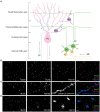
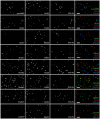
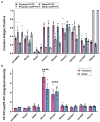
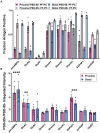

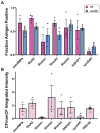
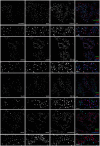
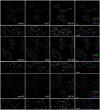
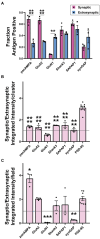


Similar articles
-
Cerebellar Shank2 Regulates Excitatory Synapse Density, Motor Coordination, and Specific Repetitive and Anxiety-Like Behaviors.J Neurosci. 2016 Nov 30;36(48):12129-12143. doi: 10.1523/JNEUROSCI.1849-16.2016. J Neurosci. 2016. PMID: 27903723 Free PMC article.
-
Differential localization of delta glutamate receptors in the rat cerebellum: coexpression with AMPA receptors in parallel fiber-spine synapses and absence from climbing fiber-spine synapses.J Neurosci. 1997 Jan 15;17(2):834-42. doi: 10.1523/JNEUROSCI.17-02-00834.1997. J Neurosci. 1997. PMID: 8987804 Free PMC article.
-
Critical period for activity-dependent synapse elimination in developing cerebellum.J Neurosci. 2000 Jul 1;20(13):4954-61. doi: 10.1523/JNEUROSCI.20-13-04954.2000. J Neurosci. 2000. PMID: 10864953 Free PMC article.
-
Glutamate receptor antibodies in neurological diseases: anti-AMPA-GluR3 antibodies, anti-NMDA-NR1 antibodies, anti-NMDA-NR2A/B antibodies, anti-mGluR1 antibodies or anti-mGluR5 antibodies are present in subpopulations of patients with either: epilepsy, encephalitis, cerebellar ataxia, systemic lupus erythematosus (SLE) and neuropsychiatric SLE, Sjogren's syndrome, schizophrenia, mania or stroke. These autoimmune anti-glutamate receptor antibodies can bind neurons in few brain regions, activate glutamate receptors, decrease glutamate receptor's expression, impair glutamate-induced signaling and function, activate blood brain barrier endothelial cells, kill neurons, damage the brain, induce behavioral/psychiatric/cognitive abnormalities and ataxia in animal models, and can be removed or silenced in some patients by immunotherapy.J Neural Transm (Vienna). 2014 Aug;121(8):1029-75. doi: 10.1007/s00702-014-1193-3. Epub 2014 Aug 1. J Neural Transm (Vienna). 2014. PMID: 25081016 Review.
-
The organization of plasticity in the cerebellar cortex: from synapses to control.Prog Brain Res. 2014;210:31-58. doi: 10.1016/B978-0-444-63356-9.00002-9. Prog Brain Res. 2014. PMID: 24916288 Review.
References
-
- Andreescu C. E., Prestori F., Brandalise F., D'Errico A., De Jeu M. T., Rossi P., et al. . (2011). NR2A subunit of the N-methyl D-aspartate receptors are required for potentiation at the mossy fiber to granule cell synapse and vestibulo-cerebellar motor learning. Neuroscience 176, 274–283. doi: 10.1016/j.neuroscience.2010.12.024, PMID: - DOI - PubMed
-
- Bahjaoui-Bouhaddi M., Padilla F., Nicolet M., Cifuentes-Diaz C., Fellmann D., Mege R. M. (1997). Localized deposition of M-cadherin in the glomeruli of the granular layer during the postnatal development of mouse cerebellum. J. Comp. Neurol. 378, 180–195. doi: 10.1002/(SICI)1096-9861(19970210)378:2<180::AID-CNE3>3.0.CO;2-#, PMID: - DOI - PubMed
LinkOut - more resources
Full Text Sources
Molecular Biology Databases

